Both members of the Esox family, northern pike and muskellunge are absolute favorites among many sports anglers. These northern freshwater fish are known for fierce fighting, huge sizes, and for just being fun as all heck to go after.
There are many defining features that help you tell a musky from a pike. The most obvious include horizontal spotted pattern (pike) vs. vertical lines (musky), rounded tail fins (pike) vs. pointed tail fins (musky), and 5 or less pores on the lower jaw (pike) vs. 6-9 on musky.
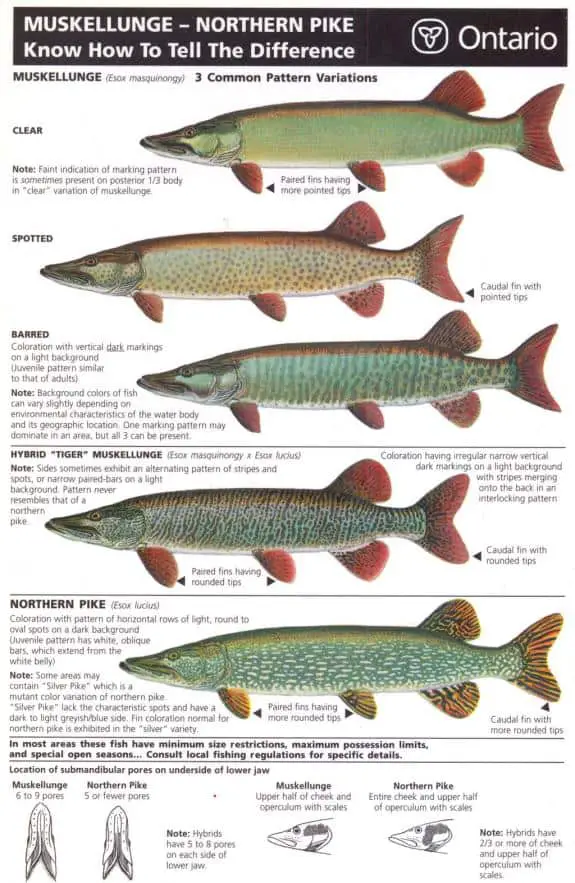
To be honest, the clear spotting of the pike that moves horizontally versus the vertical solid lines of the most common musky (barred pattern) should pretty much always make it really clear if you are dealing with a pike or a musky. They are very different looking patterns.
That said, there are many differences between these giants in the Esox family, and understanding the other traits can be important when identifying a tiger musky or pike-pickerel hybrid.
There are also spotted muskie and clear muskie, which have patterns which are much closer to a pike’s general pattern as opposed to the barred muskie’s pattern which really sticks out as being different.
Telling Muskie & Pike Apart
There are certain differences that can be seen between all muskie and northern pike. Many of these aren’t the first thing that will stick out when trying to identifying one fish from another.
But they are identifying marks worth knowing because they always apply, regardless of whether the muskie is spotted, barred, clear, or the hybrid tiger muskie.
So first, start with the general:
Basic rule of thumb for telling muskies and pike apart:
- Pike have dark bodies with light markings on top
- Muskie have light bodies with dark markings on top
While this won’t make the answer clear every single time, it is an extremely good rule of thumb that is correct well over 90% of the time.
What do the tail fins tell you?
The quickest identifying mark in many cases is looking at the tail fin. As long as you’re not dealing with a hybrid, muskie tend to have sharp tail fins. Very angular, very pointed, and very distinctive.
While pike also has relatively pointed fins, they are much more rounded than what you see from a muskie. Especially around the corners/ends.
Submandibular Pores (holes under the jaw)
If there are less than six sets of pores underneath the jaw, then you are definitely looking at a northern pike. Six is the weird number. While pike usually don’t have six pairs, it’s not unheard of. Muskie usually have more, but they can also have as few as six pairs.
If they have more than six pairs of these pores then you are definitely dealing with a muskie as opposed to a pike.
Is the cheek scaled?
If the cheek is fully scaled then you are definitely dealing with a northern pike. If the cheek is only partially scaled then you are dealing with a muskie or a hybrid.
Is the teardrop missing?
Pickerels have large distinctive teardrop marks under the eye. Pike have a very thin teardrop mark that moves vertically under the eye. Most muskie do, as well, though some muskie don’t have that mark at all.
If there is no teardrop at all then you are almost certainly dealing with a muskie.
Telling Northern Pike and Barred Muskie Apart
This is the most common pattern that most muskie are known for, and the pattern that I think most of us think of when thinking about the muskellunge.
In this case telling the two fish apart is actually pretty easy. As this side by side picture shows:
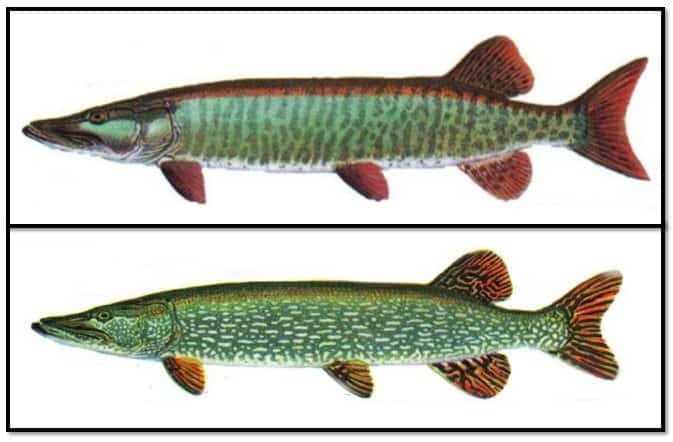
These two fish are pretty easy to tell apart. For one thing the pike has a dark body with light markings that run horizontally, or from left to right. This is in stark contrast to the barred muskie’s light colored body with much darker marks that run vertically.
If the pattern looks like Morse code, you’re definitely dealing with pike. The distinctive difference in patterns makes these pretty easy to tell apart.
Anglers shouldn’t have too much trouble seeing the difference between a northern pike and a muskie featuring a barred pattern.
So to summarize:
- The pike has a dark body while the barred muskie has a light body
- The pike has light markings while the muskie has dark markings
- The pike’s dots run horizontally while the barred muskie’s marks run vertically
- The pike has dots or small dash patterns vs the barred muskie’s long vertical lines
Telling Northern Pike and Spotted Muskie Apart
Now among the muskie this is the one that is easiest to mistake with a northern pike. You can definitely tell these two fish are cousins in the Esox family!
That being said, even beyond the muskie vs. pike differences that apply to all of these fish, there are a few key ways you can tell if you’re dealing with a northern pike versus a muskie featuring the most common spotted pattern.
One is to look closely at the pattern. If there are only dots or spots and no dashes or lines, you’re probably dealing with a muskie. Pike patterns tend to have a lot of small dots, but they have even more small and medium dashes.
Also study direction. With spotted muskie you won’t really be able to see if the pattern is running horizontally or vertically. They will just look like they have spots all around the body.
On the other hand a northern pike will have dashes and dots that clearly seem to run in more horizontal patterns. If you’re seeing a lot of dashes, you’re not dealing with a spotted musky.
Take a look at those differences in the picture below:
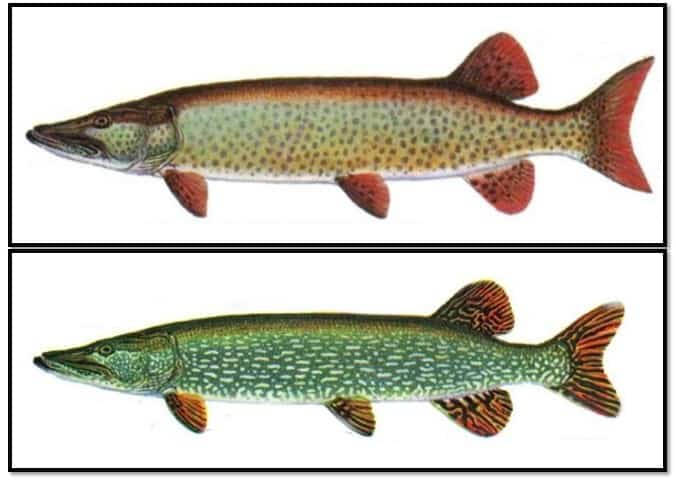
As you can see when you’re looking for the pattern – the spotted musky is actually very different from the pike when you know what to look for. As always the tail is a pretty solid giveaway, as well!
So to summarize:
- Spotted muskie won’t have a discernible vertical or horizontal pattern: just spots vs pike always having lines running horizontally
- Vertical bars near the tail mean it’s a spotted muskie
Telling Northern Pike and Clear Muskie Apart
The clear muskie, to me, is the oddest looking of these four fish. The good news is that makes them quite easy to tell apart. On clear muskie the pattern is actually quite faint on most of its body, with the very back showing distinctive lines similar to the barred muskie.
There usually is not major coloration difference on most of the fish’s body, which is a dead giveaway right off the bat.
With pike there is clearly a dark green and a light green, not to mention a pattern that runs across the entire body. If you have to squint to see any pattern, you’re not dealing with a pike.
Add in the fact that those bars by the tail pretty much scream “Muskie” and you’ve got a pretty easy ID there.
You shouldn’t have any trouble at all telling a clear patterned musky from a northern pike, as the picture below now shows.
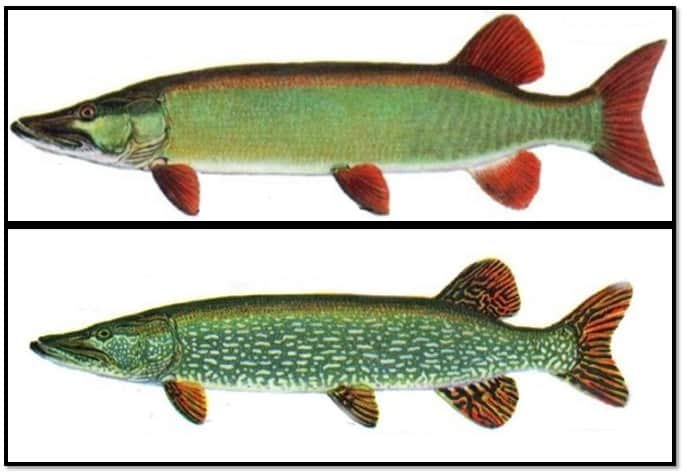
Yup, that’s about the easiest ID on the list, and that’s saying something 🙂
So to summarize:
- If you can’t find a pattern, it’s a musky with a clear pattern
Telling Northern Pike and Tiger Muskie Apart
This can actually be a bit more challenging seeing as how your average tiger muskie can actually vary quite a bit. So much so that we wrote an entire article comparing the tiger muskie vs. muskie where we noted how some tiger muskie are called “tiger pike” by anglers who catch them. Because of their similarities to pike.
So keeping in mind that the hybrid tiger muskie you pull from a lake might not be as clear cut different as the one in the comparison picture below, there are still things to look for.
One is the pattern. The majority of tiger muskies are still going to have a vertical pattern. This is not 100% the case, but it is the case a heavy majority of the time. That means even with a “spot and line” pattern you may be able to tell the difference because the pike’s pattern will always be horizontal, not vertical.
Vertical is a dead giveaway you’re dealing with some type of muskie.
Remember that a tiger muskie can have characteristics of both fish, but a pike will never have the characteristic of a muskie. In the picture below you have to run through vertical pattern vs. horizontal pattern, dark background/light markings vs. light background/dark markings, but it is doable.
It also won’t always be this clear and that’s when checking all the potential differences will help you tell them apart. Especially since some tiger muskies will have 10 northern pike traits with only 1-2 giveaways that they are actually a musky-pike hybrid.
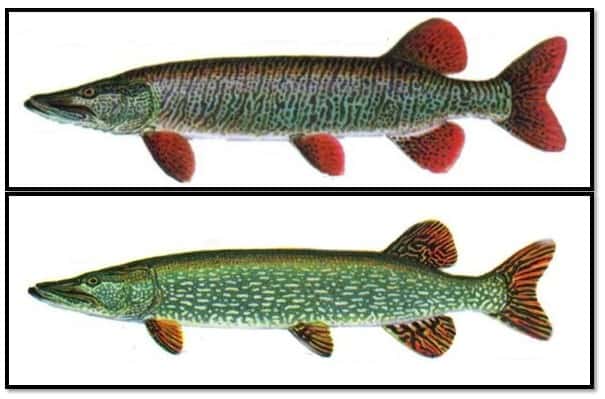
This will almost certainly be one of the most challenging ones to tell apart.
So to summarize:
- If there are any distinctively muskie traits, it’s a muskie
- Look for a tell-tale sign like a vertical pattern
- You may need to fall to the “always musky” or “always pike” general lists to make a final analysis on a pike vs. tiger pike situation
Video Talking About Differences Between Esox Fish
While there can be the occasional genetic mutation or hybrid that really throws you off, for the most part telling these fish apart is actually pretty easy once you know what you’re looking for.
Now telling a muskie and tiger muskie apart: that’s a serious challenge!
Especially for those tiger muskie that don’t take heavily after the pike family, aka the opposite of “Tiger Pike.”
There you are. Plenty of visuals, list of traits, and you now have the knowledge you need to tell a pike from a musky or vice-versa.
And if you’re looking for some gear advice, consider visiting our Recommended Gear page for our top pick for a variety of different tools to make sure you have a fighting chance of bringing in that trophy pike or muskie.
In Conclusion
So as you can see, there are plenty of ways to tell the northern pike apart from a muskellunge. While some traits are more obvious than others, by understanding both fish thoroughly you will be able to easily and quickly identify even the weirdest of genetic anomalies among these amazing giant freshwater fish.
Other Pike Articles We Think You’ll Like
